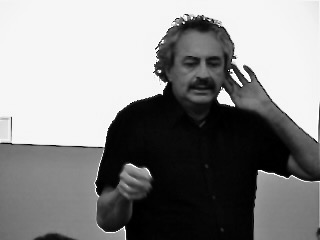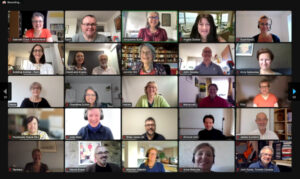It could have been just another Wednesday practice group evening, held in the training rooms at the Centre for Learning and Development, Garth House, Pinderfields General Hospital, Wakefield, West Yorkshire. Tea in the hospital dining room, coffee whilst waiting for five or six people to turn up, and then a couple of hours playing with Clean Language patterns.
However, this Wednesday evening was a bit special. At 5pm (just as we were ready to go up to the dining room) David Grove arrived! David had driven down from Durham specially to visit the practice group (what a start!?).

After tea and the usual round of coffee people started turning up, nearly twenty five in all ! I’d set the seats out in the training room with two at the front, but David didn’t sit there, he sat in the middle of the group. And then he started.
What follows isn’t a word for word transcript, it’s an account based on my notes and memories of the evening. David gave some wonderful demonstrations of Clean Language in action, and he started by describing to the group some of the basic tenets of Clean Language.
“It’s not a language of discourse.”
David is strong on this point, that Clean Language is not about having a conversation. One of the main considerations is “where is the locus, the centre point of your piece of communication?” he asks.
David gave the example of “I want you to tell me about yourself”, and how the locus shifts. “I want” (speaker) “you” (to the subject) “to tell me” (back to the speaker) “about” (somewhere) “yourself” (back to the subject). Here the locus is moving backwards and forwards.
With Clean Language the locus shifts to the other person and stays there, it resides in their experience, which is why Clean Language questions are felt.
He then went on to talk about how Clean Language is information centred. Instead of the locus moving backwards and forwards, as it does in the me-discussion-you type set up, the locus stays with the information coming from the client – that is, it doesn’t stay with the questioner OR the client but with the information. David explained how the word “you” is disastrous in terms of Clean Language, since it goes to the ego state which can do nothing. It also discriminates, ignoring the basic principle which is that ALL information is of importance.
Repetition is also important in Clean Language, by packing the active component (the repeating of the client’s own words) in an inert substance (the expanded syntax of a Clean Language question) it becomes more powerful. This is allied to the delivery of the question and the importance of the rhythm, tone and poetry of the questions. A good Clean Language question feels right rather than being grammatically right. Ending a question with the client’s own words ‘rhymes’ with them even though it may not be grammatically ‘right’. As David said,:
“It’s Clean Language when it feels right”.
This often means that Clean Language is very easy for the client but operationally very hard for the questioner. The pessimist’s view is that you’re only as good as your last question. Optimists, however, believe that you’re only as good as your next question.
A good way to end a session, David suggested, is to ask the client what questions of yours were not good question and which questions would have worked better.
Next, David went on to discuss why Clean Language is able to delve so deeply (my metaphor, ed.) into a person’s interior-scape. Imagery is our primary processing system, and language our secondary. Symbols are closer to images than they are to verbal descriptions, and so a person might be able to see or imagine a symbol without being able to fully describe it.
Clean Language works with this unseen and un-verbalised description, it can work with movements, gestures, coughs, lines of sight and so on, it doesn’t depend on the client being able to provide a full linguistic description of a symbol. This is what David termed being an equal opportunities employer, not discriminating against other forms of information. How can a hand gesture be used? In the approach of Clean Language there is information held in the choreography of that hand gesture. Clean Language is about the management of time and the management of space.
David described the difference between a conversation and Clean Language with the following example. Conversation follows a line. He asked one of the group, B, for a statement. B said “No”. David went on to show that asking a cognitive question “Why not?” simply moved the locus back to the questioner and moved the question on. (The answer given was “I don’t understand what you said.”)
David then used a Clean Language question, and explained (demonstrated!) how this had the effect of stopping the progress of the conversation and going between the lines (so to speak). With the conversation paused in that moment David was able to identify and evolve symbols and metaphors which contained the entire meaning of that single word, ‘No’. Talk about surface structure being a deleted form of deep structure!
At the end of the impromptu demonstration (which involved evolving B’s symbols) David again asked her for a statement – she looked him straight in the eyes and said “…and when it’s a statement, what kind of statement is that statement?” – Rock on !!!
David then went on to describe how, in the case of phobia or trauma, the individual is frozen in time, at that moment just before the event. It’s like a falling dream, you never hit the bottom, and so a client’s experience of the event is always stuck at that moment just before. David labels the event itself as “T” and the moment just before as “T-1”.
Healing involves taking something from T-1 to T+1. Trying to go “through” T often causes disassociation and fragmentation, the whole problem is that the client can’t go through T. Clean Language goes around, above, below T. It evolves the information around T and into T+1, and it does this in the form of metaphors and symbols.
Another point of guidance David gave was – if it won’t go forwards, move it backwards, with the questions “what happened just before?” and “where did that come from?”
That took us up to a coffee break. During the day we (in the Centre for Learning and Development) had had the coffee vending machine on free vend, and no-one had changed it. So the group had the luxury of free drinks, and free access to the large plate of biscuits left over from a meeting earlier in the day.
Then we started again.
David had brought with him, as it were, an exercise called Words that Wound. I’ve described the exercise separately and in detail, but here are some of the comments David made during the two demonstrations (and guess who ended up being one of the demonstration subjects !??)
During the demonstration (which concentrated on the experience of having been on the receiving end of hurtful words) David evolved the experience into a symbol, some form of object. The purpose was in the definition of the word metaphor, meaning to pick up and carry across. Once an experience has evolved into a symbol (an object) it can be picked up and carried across. Clean Language ‘nounerises’ things. I wondered if this was akin to the NLP concept of ‘nominalisations’.
Within a problem there are symptoms, and symptoms are a person’s unsuccessful attempts to heal themselves. In Clean Language there is no attempt to remove a symptom, but instead to honour it and help it achieve its aim, the symptom has within it the seed for its own healing. One of the first steps is to evolve the symptom or the experience of the symptom into an object. This object can then evolve. David thinks of the symbols and metaphors as containers of information, and as being more intelligent than the client!
The evening had to end sometime, and that brought us to the end.
I’d like to thank everyone who turned up and everyone who’s supported us and the development of Clean Language, but a particularly big thank you to David Grove for spending the evening with us and sharing so freely the skills and approaches he has developed.








